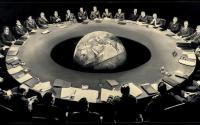 A NASA image of the Arctic Ocean’s remarkable ice retreat in September 2007. (Credit: AFP/Getty Images)
A NASA image of the Arctic Ocean’s remarkable ice retreat in September 2007. (Credit: AFP/Getty Images)The left-leaning Guardian newspaper of Britain has put the Danish political scientist Bjorn Lomborg — anathema to many environmental scientists and campaigners for challenging projections of ecological doom — on a list of “50 People Who Could Save the Planet” with the Nobel Peace Prize winners Al Gore and Wangari Maathai, the movie star and environmental filmmaker Leonardo DiCaprio, and NASA climatologist Gavin Schmidt.
The newspaper, which published the list over the weekend, explained its search this way: “Who are the people who can bring about change, the pioneers coming up with radical solutions? We can modify our lifestyles, but that will never be enough. Who are the politicians most able to force society and industry to do things differently? Where are the green shoots that will get us out of the global ecological mess?”
The Guardian sought nominations from a wide array of people, including Robert Watson, formerly the chief scientist of the World Bank and chairman of the Intergovernmental Panel on Climate Change, Gerd Leipold, the head of Greenpeace International, and the novelist Philip Pullman. The paper’s science, environment and economics correspondents added their own candidates, then winnowed away.
“Great names were argued over, and unknown ones surfaced,” wrote John Vidal, the paper’s environment editor. He said Mr. Gore, despite his high profile, was a close call: “He may have put climate change on the rich countries’ agenda, but some felt his solution of trading emissions is not enough and no more than what all major businesses and western governments are now saying. But in the end he squeaked through.”
Mr. Vidal explained the inclusion of Mr. DiCaprio this way: “It would be easy to sniff at someone who seemed to have merely pledged to forgo private jets and made a couple of films about the environment, but we felt the Hollywood superstar who has grabbed the green agenda had to be included because of the worldwide influence he is expected to have. Thanks to his massive celebrity status, DiCaprio could be a crucial figure in persuading and leading the next generation.”
Dr. Lomborg (PhD in political science) and Dr. Schmidt (PhD in applied mathematics), who works with NASA’s top climatologist, James Hansen, are worlds apart in their views on global warming.
How did they both make the list? (One possible theory: it’s a good way to get media coverage of the announcement.)
The paper said that Dr. Lomborg “has become an essential check and balance to runaway environmental excitement. In 2004, the Dane made his name as a green contrarian with his bestselling book The Skeptical Environmentalist, and outraged scientists and green groups around the world by arguing that many claims about global warming, overpopulation, energy resources, deforestation, species loss and water shortages are not supported by analysis. He was accused of scientific dishonesty, but cleared his name. He doesn’t dispute the science of climate change, but questions the priority it is given. He may look increasingly out of step, but Lomborg is one of the few academics prepared to challenge the consensus with credible data.”
As for Dr. Schmidt? The paper credited him for co-founding RealClimate.org in 2004. It said “the site has quickly become a must-read for interested amateurs, and a perfect foil to both the climate skeptic misinformation that saturates sections of the web and the overexcitement of the claims of some environmentalists.” It added that “the site has a policy of not getting dragged into the political or economic aspects of science, but it’s fairly easy to guess which side it’s on.”
If you could assemble such a list, who would be on, or off? And given that it’s aimed at people who could save the planet (meaning they have not done so yet), what is it they should be doing?
 Freeway traffic on near Los Angeles. (Credit: Monica Almeida/The New York Times)
Freeway traffic on near Los Angeles. (Credit: Monica Almeida/The New York Times)



















